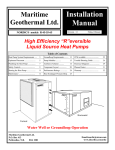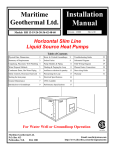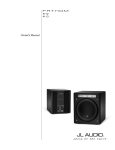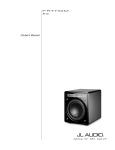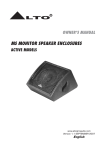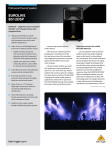Download Dell T5SA User's Manual
Transcript
The lightning flash with arrowhead symbol within an equilateral triangle is intended to alert the user to the presence of uninsulated "dangerous voltage" within the product's enclosure, that may be of sufficient magnitude to constitute a risk of electric shock to persons. The exclamation point within an equilateral triangle is intended to alert the user to the presence of important operating and maintenance (servicing) instructions in the literature accompanying the appliance. IMPORTANT SAFETY INSTRUCTIONS INSTRUCTIONS PERTAINING TO A RISK OF FIRE, ELECTRIC SHOCK OR INJURY TO PERSONS WARNING - When using electric products, basic precautions should always be followed, including the following: 1. Read all the SAFETY INSTRUCTIONS before using the product. 2. To reduce the risk of injury, close supervision is necessary when the product is used near children. 3. Do not use this product near water - for example, near a bathtub, washbowl, kitchen sink, in a wet basement or near a swimming poor or the like. 4. This product in combination may be capable of producing sound levels that could cause permanent hearing loss. Do not operate for a long period of time at high volume level or at a level that is uncomfortable. If you experience any hearing loss or ringing in the ears, you should consult an audiologist. 5. This product should be located so that its location or position does not interfere with its proper ventilation. 6. This product should be located away from heat sources such as radiators, heat registers or other products that produce heat. 7. The product should be connected to a power supply only of the type described on the operating instructions or as marked on the product. 8. This product may be equipped with a polarized line plug (one blade wider than the other). This is a safety feature. If you are unable to insert the plug into the outlet, contact an electrician to replace your obsolete outlet. Do not defeat the safety purpose of the plug. 9. The power-supply cord of the product should be unplugged from the outlet when left unused for a long period of time. When unplugging the power-supply cord, do not pull on the cord, but grasp it by the plug. 10. Care should be taken so that object do not fall and liquid are not spilled into the enclosure through openings. 11. The product should be serviced by qualified service personnel when: A. The power-supply cord or the plug has been damaged; or B. Objects have fallen, or liquid has been spilled into the product; or C. The product has been exposed to rain; or D. The product does not appear to operate normally or exhibits a marked change in performance; or E. The product has been dropped or the enclosure damaged. 12. Do not attempt to service the product beyond that described in the user-maintenance instructions. All other servicing should be referred to qualified service personnel. 13. WARNING - Do not place objects on the product's power cord or place it in a position where anyone could trip over, walk on or roll anything over it. Do not allow the product to rest on or to be installed over power cords of any type. Improper installations of this type create the possibility of fire hazard and/or personal injury. SAVE THESE INSTRUCTIONS 1. Introduzione Congratulazioni per l'acquisto del sistema di diffusione T5SA! Per un impiego corretto del sistema seguite le istruzioni riportate in questo manuale. Buon divertimento e buon lavoro! 2. Sommario 4. Il sistema T5SA (fig. 1) 3. Norme di Installazione e Uso . . . . . . . . . . 3 1. La protezione e la manutenzione . . . . . . . . . . . . 2. Prevenzione di possibili disturbi . . . . . . . . . . . . . 3. Collegamenti . . . . . . . . . . . . . . . . . . . . . . . . . . . . 4. I cavi di collegamento . . . . . . . . . . . . . . . . . . . . . 3 3 3 3 4. Il sistema T5SA . . . . . . . . . . . . . . . . . . . . . 3 5. Installazione e collegamenti . . . . . . . . . . 4 1. Installazione . . . . . . . . . . . . . . . . . . . . . . . . . . . . . 4 2. Collegamenti . . . . . . . . . . . . . . . . . . . . . . . . . . . . 4 6. Modulo DPPM - Pannello connessioni . . 7. PRESETS . . . . . . . . . . . . . . . . . . . . . . . . . . 8. Il sistema di protezione . . . . . . . . . . . . . . 9. Funzionamento dei PLUGINS . . . . . . . . . 10. Specifiche tecniche. . . . . . . . . . . . . . . . . L’utilizzo di cavi non schermati potrebbe determinare l’insorgere di fastidiosi ronzii e rumori di fondo. Verificate periodicamente che i cavi impiegati siano in buono stato, con le connessioni realizzate nel modo corretto e con tutti i contatti in perfetta efficienza, in modo da evitare inconvenienti come falsi contatti, rumori di massa, scariche, ecc. 4 4 5 5 6 3. Norme di Installazione e Uso 1. La protezione e la manutenzione. Evitate di collocare i diffusori in vicinanza di forti fonti di calore e di esporli direttamente alla luce solare, alla pioggia, all’umidità, alla polvere o ad intense vibrazioni. Lasciate l’apposita griglia di protezione sempre applicata ai diffusori. In caso di avaria non aprite il diffusore, ma rivolgetevi al più vicino Centro di Assistenza GENERALMUSIC. 2. Prevenzione di possibili disturbi. Collegando gli apparati del vostro impianto audio, fate attenzione ai cosiddetti “loop di massa” che potrebbero causare ronzii: in caso di disturbi, provate ad agire sullo switch SHIELD posto sul pannello controlli del diffusore. 3. Collegamenti Prima di collegare i diffusori alla presa di corrente, accertatevi che la tensione di rete corrisponda a quella indicata sul retro dell’apparato (è accettata una tolleranza fino a ±10%). Collegate il cavo di alimentazione al diffusore sempre prima di accenderlo e rimuovete il cavo sempre dopo aver spento il diffusore. Per evitare pericolosi picchi di segnale effettuate i collegamenti con altri apparati sempre a diffusore spento e accendete sempre prima il mixer e poi il diffusore. 4. I cavi di collegamento Per il collegamento dei diffusori al mixer accertatevi di utilizzare sempre e solo cavi di segnale schermati costituiti da due fili più una calza che funge da schermo. 3 T5SA è un sistema di sub-woofer che integra in un unico prodotto altoparlante, processore digitale ed amplificatore di potenza. Alloggiato in un cabinet in legno multi-strato, utilizza un woofer a lunga escursione da 15” con magnete in neodimio e bobina da 4”. T5SA è alimentato dal modulo di amplificazione DPPM Digitally Processed Power Module che include un amplificatore da 500W per il woofer ed un processore digitale che effettua tutte le operazioni di trattamento del segnale e di controllo del sistema (vedi fig. 2): - filtri di CROSSOVER HPF e LPF configurabili come Butterworth, Bessel o Linkwitz/Riley a 6, 12, 24 o 48 dB/ott.; - fino a 15 filtri EQ configurabili come FULL PARAMETRIC, HI e LO SHELVING a 6 o 12 dB e NOTCH FILTER; - DELAY LINE per l’ALLINEAMENTO in fase; - correzione di FASE con step di 5° per un range complessivo di 360°; - sistema integrato di protezione con LIMITER sulla potenza di picco, protezione in potenza media contro il surriscaldamento della bobina degli altoparlanti e LFC (Low Frequency Control). Sono disponibili, inoltre, 2 PLUGINS aggiuntivi, MULTICOMP (compressore multibanda) e NOISE GATE (filtro di riduzione del rumore di fondo) che consentono di incrementare ulteriormente le potenzialità del sistema. Il processore digitale include 16 PRESETS con i parametri di funzionamento (crossover, equalizzazione, ecc.) adatti per diversi tipi di utilizzo o per l’accoppiamento con diversi modelli di satellite, che possono essere selezionati direttamente dal pannello di controllo. T5SA è stato progettato per incrementare la risposta alle basse frequenze dei diffusori della serie TITANIUM e della d400, con cui condivide lo stesso processore digitale. Pertanto nel sistema sono inclusi una serie di PRESETS da utilizzare per l’accoppiamento del subwoofer con la d400 ed i vari modelli della serie TITANIUM. Sono presenti, inoltre, alcuni PRESETS generici con diversi tagli di frequenza per l’utilizzo del sub-woofer anche con altri diffusori. IMPORTANTE!!! Le uscite del T5SA (LINK) rilanciano verso l’esterno lo stesso segnale presente in ingresso. Pertanto, nel caso si utilizzi il sub-woofer con la d400 ed i diffusori della serie TITANIUM, è il processore digitale contenuto nei satelliti che provvede a filtrare le basse frequenze. Nel caso, invece, si utilizzino come satelliti altri diffusori non dotati di processore interno, è necessario provvedere a filtrare le basse frequenze tramite un crossover esterno. 5. Installazione e collegamenti 1. Installazione e trasporto (fig. 1) T5SA è dotato di un adattatore per l’utilizzo di un supporto telescopico standard per l’installazione del satellite sopra il sub-woofer. Inoltre possiede 4 ruote sul pannello posteriore per facilitare al massimo il trasporto del diffusore. 2. Collegamenti T5SA possiede due ingressi bilanciati LEFT e RIGHT con connettore XLR-F e due uscite con connettore XLRM per il rilancio del segnale verso i satelliti (fig. 3). A seconda del tipo di configurazione è possibile utilizzare entrambi gli ingressi oppure uno solo di essi (fig. 4). - CONFIGURAZIONE MONO (fig. 4a): il sub-woofer riceve il segnale da una sola delle uscite LEFT o RIGHT che viene collegata ad uno solo degli ingressi. Il segnale viene poi rilanciato verso il satellite (o anche verso più satelliti) e l’insieme sub + satellite riproduce la componente LEFT o RIGHT del programma stereo. Questa configurazione è quella utilizzata più comunemente e, per quanto riguarda i diffusori LEM, è quella consigliata per d400 e per i modelli T4A, T5A, T6A, T4MA e T5MA. - CONFIGURAZIONE STEREO (fig. 4b): il sub-woofer riceve entrambi i segnali LEFT o RIGHT da entrambe le uscite del mixer collegate ad entrambi gli ingressi. Il segnale viene poi rilanciato verso due satelliti e l’insieme sub + due satelliti riproduce l’intero programma stereo. Questa configurazione è consigliata per l’utilizzo con satelliti di potenza non superiore ai 200/300W. Nel caso dei diffusori LEM può essere impiegata con il modello T3A, per sui è disponibile un PRESET dedicato. Nel caso di utilizzo di diffusori di altre marche sarà necessario, probabilmente, abbassare il livello del sub rispetto a quello dei satelliti in modo da ottenere un bilanciamento ottimale. Potete regolare il livello del segnale in ingresso tramite il controllo VOL. Con il controllo completamente ruotato verso destra la sensibilità di ingresso è quella nominale (+4dB). Per ridurre il livello del sub potete ruotare il potenziometro verso sinistra riducendo il guadagno fino alla chiusura completa. 6. Modulo DPPM - Pannello connessioni (fig. 5) 1. Presa per il cavo di alimentazione. 2. Interruttore di accensione/spegnimento con LED di segnalazione 3. Connettori XLR-F bilanciato per il collegamento del segnale in ingresso (INPUT). 4. Connettori XLR-M bilanciato per il rilancio del segnale verso i satelliti o verso una seconda unità (LINK). 5. Controllo di separazione della massa elettrica dalla massa del telaio. 6. LED bi-colore per la segnalazione della presenza di segnale in ingresso (colore VERDE) oppure dell’intervento del LIMITER interno (colore ROSSO). 7. Controllo del livello in ingresso. 8. Selettore a 16 posizioni per la selezione dei PRESETS. 9. Prese d’aria per il raffreddamento del modulo di amplificazione. ATTENZIONE!!! PER NON COMPROMETTERE IL CORRETTO FUNZIONAMENTO DEL MODULO, E’ MOLTO IMPORTANTE CHE LE PRESE D’ARIA SIANO MANTENUTE SEMPRE LIBERE, PER CONSENTIRE UNA CORRETTA CIRCOLAZIONE DELL’ARIA DI RAFFREDDAMENTO. 7. PRESETS I PRESETS disponibili in T5SA sono stati elaborati da LEM in collaborazione con fonici ed ingegneri del suono allo scopo di dotare il sub-woofer di risposte timbriche e dinamiche diverse a seconda del tipo di satellite utilizzato, del tipo di segnale riprodotto e del gusto personale. Ciascun PRESET include i filtri di crossover e di equalizzazione più adatti per l’accoppiamento ottimale del sub-woofer con i vari modelli della serie TITANIUM e con la d400. Sono, inoltre, disponibili PRESETS generici per l’utilizzo con diffusori di altre marche. Per la scelta dei PRESETS vi consigliamo in primo luogo di seguire le indicazioni riportate di seguito e relative ai diversi modelli di satelliti, ma anche di affidarvi all’ascolto e alle vostre valutazioni personali. Nella figura 6 alla fine del manuale sono riportate le curve di risposta di tutti i PRESET inclusi in T5SA. 01. d400: da utilizzare per l’accoppiamento del subwoofer con il diffusore d400. 4 02. d400 HOUSE: derivato dal precedente, include l’utilizzo del MULTICOMP per enfatizzare le frequenza basse al di sotto dei 60Hz. Particolarmente adatto alla riproduzione della musica house e dance in genere. 03. 2xT3A + 2xT5SA: da utilizzare in un sistema STEREO comprendente due diffusori T3A come satelliti e due T5SA come sub-woofer (vedi paragrafo 2. Collegamenti e fig. 4a). 04. 2xT3A + 1xT5SA: da utilizzare in un sistema STEREO comprendente due diffusori T3A come satelliti e un T5SA come sub-woofer (vedi paragrafo 2. Collegamenti e fig. 4b). Questo PRESET è derivato dal precedente con una riduzione del livello del sub ed un diverso filtro di crossover. 05. T4A: da utilizzare per l’accoppiamento del subwoofer con il diffusore T4A. 06. T4A HOUSE: derivato dal precedente, include l’utilizzo del MULTICOMP per enfatizzare le frequenza basse al di sotto dei 60Hz. Particolarmente adatto alla riproduzione della musica house e dance in genere. 07. T5A/T6A: da utilizzare per l’accoppiamento del sub-woofer con i diffusori T5A o T6A. 08. T5A/T6A HOUSE: derivato dal precedente, include l’utilizzo del MULTICOMP per enfatizzare le frequenza basse al di sotto dei 60Hz. Particolarmente adatto alla riproduzione della musica house e dance in genere. 09. T4MA: da utilizzare per l’accoppiamento del subwoofer con lo stage monitor T4MA per sistemi di drumfill (vedi Manuale d’Uso di T4MA). 10. T5MA: da utilizzare per l’accoppiamento del subwoofer con lo stage monitor T5MA per sistemi di drumfill (vedi Manuale d’Uso di T5MA). 11. 80Hz: si tratta di un PRESET con un filtro L/R a 24 dB per ottava a 80Hz, per l’utilizzo del sub-woofer con un satellite generico. 12. 100Hz: simile al precedente, include un filtro L/R a 24 dB per ottava a 100Hz. 13. 120Hz: simile al precedente, include un filtro L/R a 24 dB per ottava a 120Hz. 14. 140Hz: simile al precedente, include un filtro L/R a 24 dB per ottava a 140Hz. 15. 160Hz: simile al precedente, include un filtro L/R a 24 dB per ottava a 160Hz. 16. 180Hz: simile al precedente, include un filtro L/R a 24 dB per ottava a 180Hz. 5 8. Il sistema di protezione Il modulo DPPM di T5SA è dotato di una serie di dispositivi digitali che consentono di ottenere un livello elevatissimo di protezione dell’altoparlante e dell’amplificatore del sistema (vedi fig. 2). - LIMITER sulla potenza di PICCO: è in grado di prevenire con estrema precisione il clipping dell’amplificatore interno e, allo stesso tempo, di controllare la potenza massima di picco erogata all’altoparlante. L’intervento di questa protezione è segnalato dal LED SIGNAL/LIMIT posto sul pannello. Nota: sebbene il LIMITER digitale agisca con grande precisione ed efficacia, si consiglia di non eccedere con il livello di ingresso e di operare in una condizione in cui il LED rosso LIMIT lampeggi solo occasionalmente. - PROTEZIONE IN POTENZA CONTINUA: interviene quando il sistema viene utilizzato in modo prolungato al limite della potenza media sopportabile dall’altoparlante. Il processore digitale è in grado di rilevare se l’altoparlante stia raggiungendo la temperatura massima sopportabile dalla bobina mobile. In questo caso, il segnale (e, quindi, la potenza applicata) viene ridotto in modo graduale fino a portare l’altoparlante entro i limiti di sicurezza. Se la situazione di rischio permane, la potenza resta ridotta, mentre se si ripristina la condizione di utilizzo corretto essa viene riportata gradualmente al livello normale. Tale protezione, che agisce in modo completamente automatico ed inavvertibile, impedisce che un utilizzo esasperato del sistema possa provocare la rottura dell’altoparlante. - LFC (Low Frequency Control): si tratta di un compressore selettivo che consente di operare una ulteriore protezione su una limitata banda di frequenze alle quali il woofer è più suscettibile di possibili rotture. 9. Funzionamento dei PLUGINS - MULTICOMP: si tratta di un compressore a banda di frequenza variabile. Grazie alla possibilità di definire la banda di frequenza su cui il compressore agisce, il MULTICOMP viene utilizzato in alcuni PRESETS di T5SA per l’equalizzazione dinamica del sistema, per ottenere effetti di loudness e per applicare una protezione aggiuntiva solo su una parte della risposta in frequenza. - NOISE GATE: si tratta di un filtro dinamico in grado di eliminare il rumore di fondo proveniente dalle apparecchiature collegate ai diffusori. Il filtro di NOISE GATE è attivo in tutti i PRESETS di T5SA. 10. Specifiche tecniche T5SA • SPECIFICHE TECNICHE SPECIFICHE del DIFFUSORE Componenti Woofer da 15" Multistrato con vernice nera antigraffio - Griglia metallica di protezione Maniglie ed adattatore in metallo - 4 ruote per il trasposrto 466x600x600 43.5 Costruzione Dimensioni Peso mm (LxAxP) kg SPECIFICHE dell'AMPLIFICATORE Ingresso Convertitori A/D Convertitori D/A Crossover EQ Alignment delay sensibilità +4 dB (nominale) impedenza 20 kOhms (bilanciato) bit 24 bit 24 Range dinamico 100 dB Sampling Rate 48 kHz Tipo Bessel, Butterworth o Linkwitz-Riley Frequenza Variabile da 15.6 Hz a 16 kHz Pendenza 6, 12, 18 o 24 dB per ottava Numero 15 bande parametriche Tipo Peak, 6dB Lo-Shelf, 12dB Lo-Shelf, 6dB Hi-Shelf, 12dB Lo-Shelf, Notch Guadagno +/-15dB, variabile in step da 0.5dB Banda Da 0.05 a 3.00 ottave, variabile in step da 0.05 Frequenza Da 15.6 Hz a 16 kHz max delay 189 ms Plugins Noise Gate, Multiband compressor Limiter di picco indipendente su ciascuna uscita Protezione in potenza continua su ciascuna uscita LFC - Low Frequency Control Protezioni Potenza di uscita EIA (1kHz, THD 1%) Distorsione Controlli Connessioni Alimentazione W 500 % <0.02 Volume - Selettore PRESETS 2 x XLR-F + 2 x XLR-M vedi etichetta sull'apparato SPECIFICHE del SISTEMA Risposta in frequenza Sensibilità Hz (-10dB) MAX SPL Continuous 32 - 200 125 6 1. Introduction Congratulations for having chosen the T5SA loudspeaker system! To make the best use of the system, please read this manual thoroughly before operating the equipment. 2. Contents 3. Instructions for use and installation . . . 7 1. Protection and maintenance . . . . . . . . . . . . . . . . 2. Prevention of possible interference . . . . . . . . . . . 3. Connections . . . . . . . . . . . . . . . . . . . . . . . . . . . . . 4. Connector cables . . . . . . . . . . . . . . . . . . . . . . . . . 7 7 7 7 4. Connector cables. When connecting the enclosures to the mixer, make certain to always use only shielded signal cables made up of two wires plus a braid/shield: the use of unshielded cables could in fact probably cause annoying hum and noise. Check periodically that your cables are in good condition, correctly wired and with perfectly efficient contacts: in fact many problems and drawbacks (false contacts, ground hum, crackles, etc.) are caused by the use of unsuitable or damaged cables. 4. The T5SA system (fig. 1) 4. The T5SA system . . . . . . . . . . . . . . . . . . . 7 5. Installation and connections . . . . . . . . . . 8 1. Installation . . . . . . . . . . . . . . . . . . . . . . . . . . . . . . 8 2. Connections . . . . . . . . . . . . . . . . . . . . . . . . . . . . . 8 6. DPPM module - Connection panel . . . . . 8 7. PRESETS . . . . . . . . . . . . . . . . . . . . . . . . . . 8 8. The protection system . . . . . . . . . . . . . . . 9 9. How the PLUGINS work . . . . . . . . . . . . . . 9 10. Technical specifications . . . . . . . . . . . 10 3. Instructions for use and installation 1. Protection and maintenance. To avoid jeopardizing correct operation, it is best not to position the enclosures for long periods in exposed places (damp, high temperature, etc.), in dusty environments or those subject to strong vibrations. On this subject, it’s advisable to always leave the protective grille mounted on the enclosures. In the event of breakdown, do not open the enclosure, but contact the nearest GENERALMUSIC Service Centre. 2. Prevention of possible interference. Avoid installing your equipment in the vicinity of radios, televisions, etc., since this could cause noisy disturbance. When connecting other equipment to your sound system, pay close attention to so-called earthloops, which can cause hum: in the event of interference, try using the SHIELD switch on the unit’s control panel. 3. Connections. Before connecting the enclosures to the mains supply, make certain that the current corresponds with that indicated on the rear of the units (there is an allowance of ±10%). Always connect the power cable to the enclosures before switching them on and always remove it after having switched off. Remember to always connect or disconnect other equipment with the enclosures off and to always switch on the mixer first, then the enclosures: in this manner, annoying and often dangerous peaks are avoided. 7 T5SA is a sub-woofer that integrates in the same unit loudspeaker, amplifier and digital processor. The system, hosted in plywood cabinet, utilizes a longexcursion 15” woofer with neodymium magnet and 4” voice coil. It’s powered by the DPPM - Digitally Processed Power Module, which includes a 500W power amplifier for the woofer and a digital processor able to handle all the signal processing needed for the system control (see fig. 2): - HPF and LPF CROSSOVER filters with the choice between Butterworth, Bessel or Linkwitz/Riley response and up to 48 dB/oct. slope; - up to 15 EQ filters that can be individually set as FULL PARAMETRIC, HI and LO SHELVING (6 or 12 dB slope) or NOTCH FILTER; - DELAY LINE for the phase alignment; - PHASE adjustment with 5° step through a full 360°; - integrated protection system with high precision PEAK LIMITERS, long term power protection and LFC (Low Frequency Control). 2 additional PLUGINS are also available, which allows the system performances to be further increased: MULTICOMP (Multiband Compressor) and NOISE GATE. The digital processor includes 16 PRESETS, which can be recalled directly from the system’s panel and which include different settings suitable for the use of the subwoofer with different satellites and different configurations. T5SA, which includes the same digital processor as the d400 and the TITANIUM series loudspeakers, has been especially designed to provide a low frequency extension for these systems. For this reason, the T5SA includes some PRESETS prepared to use the subwoofer with the d400 and the different models of the TITANIUM series. In addition, some other PRESETS with different crossover filters are available for the use of the sub with loudspeakers from other brands. IMPORTANT!!! The T5SA outputs (LINK) send out the same signal received on the inputs. If you use the sub-woofer together with the d400 or one of the TITANIUM series loudspeakers, the processor included in the satellites filters the low frequencies. If you use instead as satellites loudspeakers from other brands, not provided with a built-in processor, you need to filter the low frequencies using an external crossover. 5. Installation and connections 1. Installation (fig. 3) T5SA is fitted with an adapter for the use of a telescopic loudspeaker stand for the installation of the satellite upon of the sub-woofer. In addition, four wheels are available on the rear panel in order to make the transport the easiest possible. 2. Connections T5SA is fitted with two balanced LEFT and RIGHT inputs with XLR-F connector and two outputs with XLRM connector to send the signal to the satellites or to other units. (fig. 3). According to the kind of configuration, 1 or 2 inputs can be used (fig. 4). - MONO CONFIGURATION (fig. 4a): the sub-woofer receives the signal from one of the mixer outputs (LEFT or RIGHT), which is connected only to one of the inputs. The same signal is sent to the satellite (one or more) and the sub + satellite system plays only the LEFT or RIGHT part of the stereo program. This is the most common configuration and, for what concerns LEM speakers, it is suggested for the use with the d400 and the models T4A, T5A, T6A, T4MA and T5MA of the TITANIUM series. - STEREO CONFIGURATION (fig. 4b): the sub-woofer receives both the LEFT and RIGHT signals from the mixer’s outputs, which are connected to both the inputs. The two signals are sent to two satellites and the system made of one sub + two satellites plays the whole stereo program. This configuration is suggested for the use of satellites with no more than 200/300W output power. For what concerns LEM speakers, it can be used with the T3A model as satellite (a dedicated PRESET is available in the sub-woofer). If you use loudspeakers from other brands, probably you would need to reduce the subwoofer’s level in order to obtain the proper balance between sub and satellites. The input level of the incoming signal can be set using the VOL control. If the control is rotated fully clockwise the nominal input sensitivity (+4dB) is selected. If needed, you can reduce the input gain turning the control counterclockwise. 6. DPPM module - Connection panel (fig. 6) 1. Power supply cable socket. 2. ON/OFF switch with LED indicator. 3. Balanced XLR-F sockets for the input signal connection. 4. Balanced XLR-M sockets for the signal linking to the satellites or to a second unit. 5. Control for separating the electrical earth from that of the chassis. 6. Two-color LED that illuminates when there’s a signal present at the unit’s input (GREEN color) or when the internal LIMITER is active (RED color). 7. Input level control. 8. 16-position encoder for the PRESET’s selection. 9. Air vents for the module cooling. WARNING!!! IN ORDER FOR THE MODULE TO WORK CORRECTLY, IT’S VERY IMPORTANT TO KEEP THE AIR VENTS ALWAYS FREE AND ABLE TO PROVIDE A PROPER AIR CIRCULATION. 7. PRESETS The PRESETS available in the T5SA have been prepared by LEM with the support of sound engineers and audio technicians in order to provide the sub-woofer with different acoustical and dynamic responses suitable for the use of different kind of satellites, for different applications and for different tastes. Each PRESET includes different crossover and eq filters suitable for an optimal coupling of the sub-woofer with the d400 and all the TITANIUM series models. In addition, 6 generic PRESETS with different crossover filters are available for the use of the sub-woofer with satellites from other brands. For the PRESET’s choice we suggest you to follow the directions you can find below, but also to rely on the listening and on your personal evaluations. In the fig. 6 at the end of this manual you can find the response diagrams of all the PRESETS included in the T5SA. 01. d400: for the use of the sub-woofer together with the d400 loudspeaker system. 02. d400 HOUSE: derived from the previous one, includes the use of the MULTICOMP to enhance the frequencies below 60Hz. Suitable for the use with house or dance music in general. 03. 2xT3A + 2xT5SA: to be used in a STEREO system made of two T3A loudspeakers as satellites and two T5SA as sub-woofers (see chapter 2. Connections and fig. 4a). 8 04. 2xT3A + 1xT5SA: to be used in a STEREO system two T3A loudspeakers as satellites and one T5SA as sub-woofer (see chapter 2. Connections and fig. 4b). This PRESET is derived from the previous one with a level reduction and the use of a different crossover filter. 05. T4A: for the use of the sub-woofer together with the T4A loudspeaker system. 06. T4A HOUSE: derived from the previous one, includes the use of the MULTICOMP to enhance the frequencies below 60Hz. Suitable for the use with house or dance music in general. 07. T5A/T6A: for the use of the sub-woofer together with the T5A and T6A loudspeaker system. 08. T5A/T6A HOUSE: derived from the previous one, includes the use of the MULTICOMP to enhance the frequencies below 60Hz. Suitable for the use with house or dance music in general. 09. T4MA: for the use of the sub-woofer together with the T4MA stage monitor in a drumfill systems (see T4MA Owner’s Manual). 10. T5MA: for the use of the sub-woofer together with the T5MA stage monitor in a drumfill systems (see T5MA Owner’s Manual) 11. 80Hz: this is a generic PRESET with a 24 dB/oct. 80Hz L/R crossover filter, for the use of the subwoofer with a generic satellite. 12. 100Hz: similar to the previous one, includes a 24 dB/oct. 100Hz L/R crossover filter. 13. 120Hz: similar to the previous one, includes a 24 dB/oct. 120Hz L/R crossover filter. 14. 140Hz: similar to the previous one, includes a 24 dB/oct. 140Hz L/R crossover filter. 15. 160Hz: similar to the previous one, includes a 24 dB/oct. 160Hz L/R crossover filter. 16. 180Hz: similar to the previous one, includes a 24 dB/oct. 100Hz L/R crossover filter. 8. The protection system The DPPM module includes a series of digital algorithms that allows very high level of protection of the speaker and the amplifier to be achieved (see fig. 2). - PEAK LIMITER: it is able to avoid with extreme precision the amplifier’s clipping and, at the same time, to control the maximum peak power sent to the loudspeaker. The SIGNAL/LIMIT LED on the module’s panel lights (RED color) when the LIMITERS are active. Note: even if the digital LIMITER can work with extreme precision and efficiency, it’s always advisable to avoid too high signal levels and to prevent the LIMIT LED to blink. - LONG TERM POWER PROTECTION: this protection acts when the T5SA is used continuously at the maximum power allowed for the loudspeaker. The digital processor is able to detect if the loudspeaker is reaching the maximum temperature allowable for its voice coil. In this case, the output signal (and, consequently, the power applied to the speaker) is slowly reduced in order to take back the system within safety limits. The power reduction is maintained until the critical condition remains. As soon as a normal working condition is restored, the power is gradually taken back to the nominal level. This protection, which is completely automatic and doesn’t affect the dynamic performance of the system, is able to prevent damages to the speaker when the T5SA is used in extreme conditions. - LFC (Low Frequency Control): this is a frequencydependent compressor able to perform an additional protection over a limited frequency band where the woofer is more liable to be damaged by excessive power. 9. How the PLUGINS work - MULTICOMP: it’s a compressor with selectable frequency band. Thanks to the possibility to choose the frequency band where the compressor is active, the MULTICOMP is used in some of the PRESETS included in the T5SA for the system’s dynamic EQ, to obtain loudness effects or to apply an additional protection on a defined frequency band. - NOISE GATE: it’s a dynamic filter able to eliminate the background noise coming from the devices connected to the enclosure input. The NOISE GATE filter is active on all the T5SA’s PRESETS. 9 10. Technical specifications T5SA • TECHNICAL SPECIFICATIONS LOUDSPEAKER SPECIFICATIONS Components 15" woofer Laminated birch plywood with black scratch-resistant paint - Metal grid Metal handles and speaker stand adapter - 4 wheels for trasportation 466x600x600 43.5 Construction Dimensions Weight mm (WxHxD) kg AMPLIFIER SPECIFICATIONS Input A/D converters D/A converters Crossover EQ Alignment delay sensitivity +4 dB (nominal) impedance 20 kOhms (balanced) bit 24 bit 24 Dynamic range 100 dB Sampling Rate 48 kHz Type Bessel, Butterworth or Linkwitz-Riley Frequency Variable from 15.6 Hz t 16 kHz Slope 6, 12, 18 o 24 dB/oct. Number 15 parametric bands Type Peak, 6dB Lo-Shelf, 12dB Lo-Shelf, 6dB Hi-Shelf, 12dB Lo-Shelf, Notch Gain +/-15dB, variable with 0.5dB step Bandwidth From 0.05 to 3.00 octaves, variable with 0.05dB step Frequency From 15.6 Hz to 16 kHz max delay 189 ms Plugins Noise Gate, Multiband compressor Independent PEAK LIMITER on each output Long term power protection on each output LFC - Low Frequency Control Protections Output power EIA (1kHz, THD 1%) Distortion Controls Connections Power supply W 500 % <0.02 Volume - PRESET selector 2 x XLR-F + 2 x XLR-M see label SYSTEM SPECIFICATIONS Frequency response Sensitivity Hz (-10dB) MAX SPL Continuous 32 - 200 125 10 FIG. 1 - THE SYSTEM 11 FIG. 2 - DPPM BLOCK DIAGRAM FIG. 3 - CONNECTION CABLES 12 FIG. 4 - CONNECTIONS FIG. 4a FIG. 4b 13 FIG. 5 - DPPM MODULE - Connection panel 14 FIG. 6 - PRESETS d400 T4A d400 HOUSE T4A HOUSE 2xT3A + 2xT5SA T5A / T6A 2xT3A + 1xT5SA T5A / T6A HOUSE 15 FIG. 6 - PRESETS T4MA 120Hz T5MA 140Hz 80Hz 160Hz 100Hz 180Hz 16 FEDERAL COMMUNICATIONS COMMISSION NOTE: This equipment has been tested and found to comply with the limits for a Class A digital device, pursuant to Part 15 of FCC Rules. These limits are designed to provide reasonable protection against harmful interference when the equipment is operated in a commercial environment. This equipment generates, uses and can radiate radio frequency energy and, if not installed and used in accordance with the instruction manual, may cause harmful interference to radio communications. Operations of this equipment in a residential area is likely to cause harmful interference in which case the user will be required to correct the interference at his own expense. CAUTION: Changes or modifications to this product not expressly approved by the manufacturer could void the user's authority to operate this product. Le informazioni contenute in questo documento sono state attentamente redatte e controllate. Tuttavia non è assunta alcuna responsabilità per eventuali inesattezze. Tutti i diritti sono riservati e questo documento non può essere copiato, fotocopiato, riprodotto per intero o in parte senza previo consenso scritto della GENERALMUSIC S.p.A. GENERALMUSIC si riserva il diritto di apportare senza preavviso cambiamenti e modifiche estetiche, funzionali o di design a ciascun proprio prodotto. GENERALMUSIC non assume alcuna responsabilità sull’uso o sull’applicazione dei prodotti o dei circuiti qui descritti. STAMPATO IN ITALIA The information contained in this publication has been carefully prepared and checked. However no responsibility will be taken for any errors. All rights are reserved and this document cannot be copied, photocopied or reproduced in part or completely without written consent being obtained in advance from GENERALMUSIC S.p.A. GENERALMUSIC reserves the right to make any aesthetic, functional or design modification to any of its products without any prior notice. GENERALMUSIC assumes no responsibility for the use or application of the products or circuits described herein. PRINTED IN ITALY
This document in other languages
- italiano: Dell T5SA




















